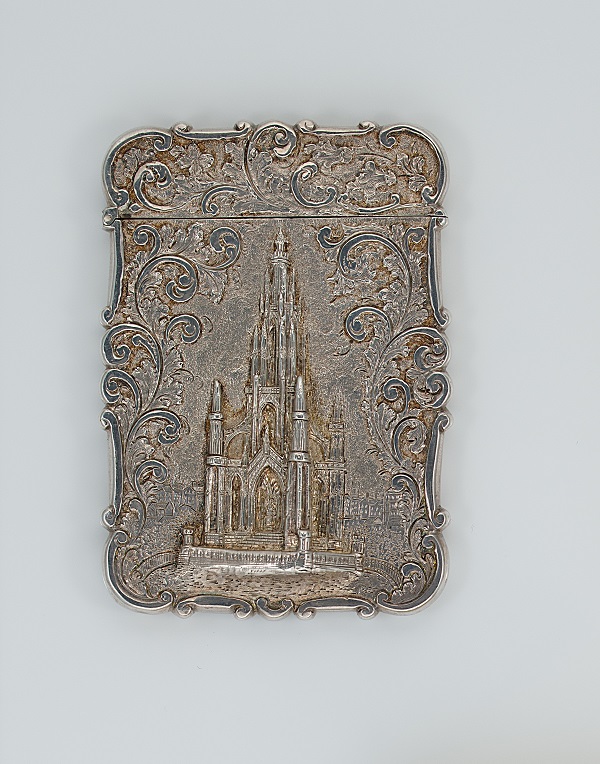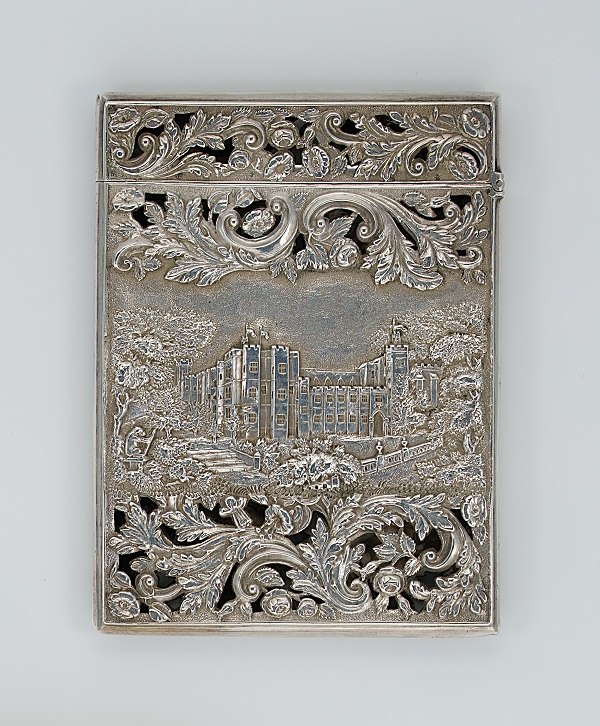Representing an important part of British social history, the silver snuffboxes and card cases made by Nathaniel Mills saw the peak of their popularity between the 1840s and 1860s. The railways were expanding at that time, creating a new tourist boom, and the wealthy and adventurous 19th century public were looking to pick up a souvenir of their adventures.
Mills capitalised on this new market, creating beautiful silver keepsakes, some decorated with images of Britain’s most famous landmarks. Quickly, these silver boxes became the height of fashion and due to their short production run they have created a niche yet active collecting field today.

Lot 282 - A Victorian silver ‘Castle Top’ style hinged card case – estimate £600-£800
But how did it all begin? There were two silversmiths called Nathaniel Mills, first the elder, and then his son, Nathaniel Mills the younger. The Mills name soon became synonymous with one of the most prolific silver box makers of the Victorian era, most famous for their ‘Castle-Top’ series of boxes and card cases.
Nathaniel Mills the elder first registered his mark in 1803 as one part of the partnership 'Mills and Langston'. They were listed as ‘Jewellers’ at 2 Northwood Street, Birmingham. In 1825 he left the partnership and concentrated on making silver objets - rather than jewellery items - on his own, registering his now famous punch mark 'NM' within a rectangle at the Birmingham Assay Office from his new address in Caroline Street, Birmingham.
Nathaniel Mills the younger worked for his father and was the brains behind ‘Castle-Top' silver; boxes and card cases decorated with British landmarks.
As many of the Nathaniel Mills box collectors at the time were also loyal monarchists, any items with a connection with Queen Victoria and Prince Albert were revered and Mills recognised this, providing the inspiration for many of his ‘Castle Top’ souvenirs. Images of Balmoral Castle, Buckingham Palace, Osborne House, and Windsor Castle were very popular,
Along with his brothers William and Thomas, Nathaniel adopted new innovations and manufacturing techniques such as engine-turning, stamping and casting.
Most ‘Castle Top’ silver is made by die stamping (pushing the metal out from behind using a stamp). The greater the decoration stands clear from the front of the cover, the harder it was to produce.

Lot 283 - A rare Victorian silver double-sided 'Castle Top' style hinged card case - estimate, £800 - £1,200
He used a gauge of silver which, despite the high relief of the image, did not easily perforate. The hinges were robust enough to withstand frequent movement and the corners and seams were well soldered and smoothed into the profile. Where he soldered a cast image onto a box, he often cleverly incorporated cast scrolling as a ‘frame’ to further cover the joint.
When it comes to collecting these boxes, and ‘Castle-Top’ examples in particular, of course quality and condition are important, however the rarer the scene and the higher the relief the more valuable the item. The record for a ‘Castle Top’ card case stands at £9,800 which was for a very rare example of The Post Office, Dublin. Occasionally large-scale collections may surface at auction, however the best in class can often be hard to come by and any would-be collectors would do well to keep an eye on regional auction houses or through specialist dealers.
There are a number of Nathaniel Mills boxes available in the next Cheffins Jewellery, Silver & Watches Sale, including two ‘Castle-Top’ examples (pictured above), one of Walter Scott Monument in Edinburgh and the other a rare double sided example showing Windsor Castle and Kenilworth Castle on the other side. Other Nathaniel Mills items include a highly decorated snuff box and two vinaigrettes.
To view the Nathaniel Mills lots in the sale click here.